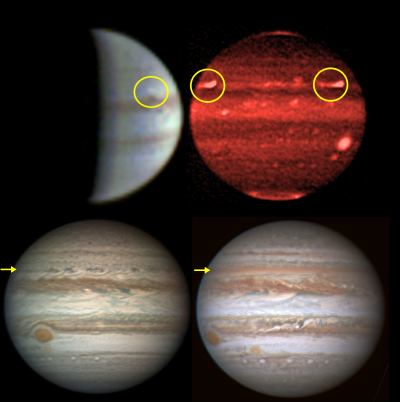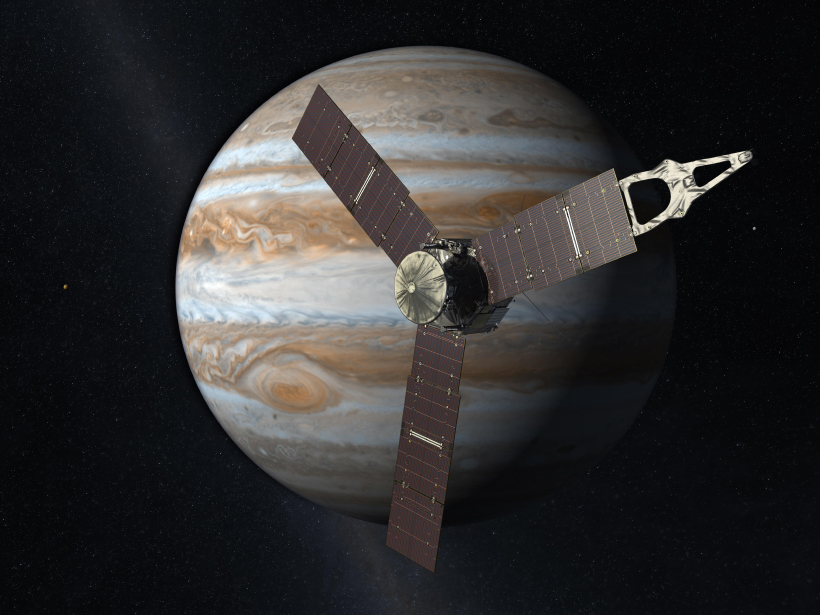Source: Geophysical Research Letters
In late 2016, a quartet of huge storms disrupted the usually stable flow of a rapid atmospheric jet stream that encircles Jupiter. Multiple instruments snapped photos of the event, and Sánchez-Lavega et al. have now used these images to investigate the progression of the disturbance.
The 2016 storm event is the most recent in an irregular cycle of similar events that disrupt the structure of the North Temperate Belt, one of several atmospheric bands that give Jupiter its stripes. The first sign of such an event is a high-altitude plume, a convective storm structure composed of upwelling gas that appears to astronomers as an elongated bright spot thousands of kilometers wide.
Between 11 and 14 October 2016, NASA’s Juno spacecraft snapped images of four such plumes distributed around Jupiter. All four plumes occurred near a latitude of 23.5°N, the southern boundary of the North Temperate Belt and the location of the fastest of several atmospheric jet streams that race around the planet. The plumes appeared to be traveling east at speeds of 155 to 175 meters per second.
To track the plumes and their effects, the team analyzed additional images from the Aula Espazio Gela Observatory, Calar Alto Observatory’s Planet Cam, the NASA Infrared Telescope Facility’s SpeX imager, and Pic du Midi Observatory. They also used images contributed by amateur astronomers to the Planetary Virtual Observatory and Laboratory.

According to the imaging data, the plumes formed between mid-September and early October. Two of the four storms likely merged quickly, and each of the three remaining plumes lasted for about 1 month. As in previous similar events, each plume interacted with the surrounding jet flow to trigger, in its wake, chaotic swirls, vortices, and other cloud patterns that persisted into November.
The turbulent effects of the plumes severely disrupted long stretches of the previously smooth North Temperate Belt, shredding it into cloud patterns of dark spots underlined by lighter-colored arcs. However, after plume activity subsided, these features began to mix and form a new, uniform, and red-colored North Temperate Belt.
Mathematical modeling enabled the researchers to simulate the interaction between the three main plume structures and the east flowing jet. The parameters required to most accurately reproduce the observed turbulent effects provided clues as to the specific wind dynamics that may have been in play. They also suggested that the huge vertical plume structures may have tilted southward.
Many questions remain about this event and similar events that occurred in 1975, 1990, 2007, and 2012. Further analysis of the 2016 disturbance and its aftermath could help scientists peer past Jupiter’s thick upper clouds and better understand the nature of the planet’s upper troposphere, as well as the deep-atmosphere mechanisms that may trigger such events and the reasons for their timing. (Geophysical Research Letters, https://doi.org/10.1002/2017GL073421, 2017)
—Sarah Stanley, Freelance Writer
Citation:
Stanley, S. (2017), Huge storms disrupted Jupiter’s fastest jet stream in 2016, Eos, 98, https://doi.org/10.1029/2017EO076413. Published on 27 June 2017.
Text © 2017. The authors. CC BY-NC-ND 3.0
Except where otherwise noted, images are subject to copyright. Any reuse without express permission from the copyright owner is prohibited.

